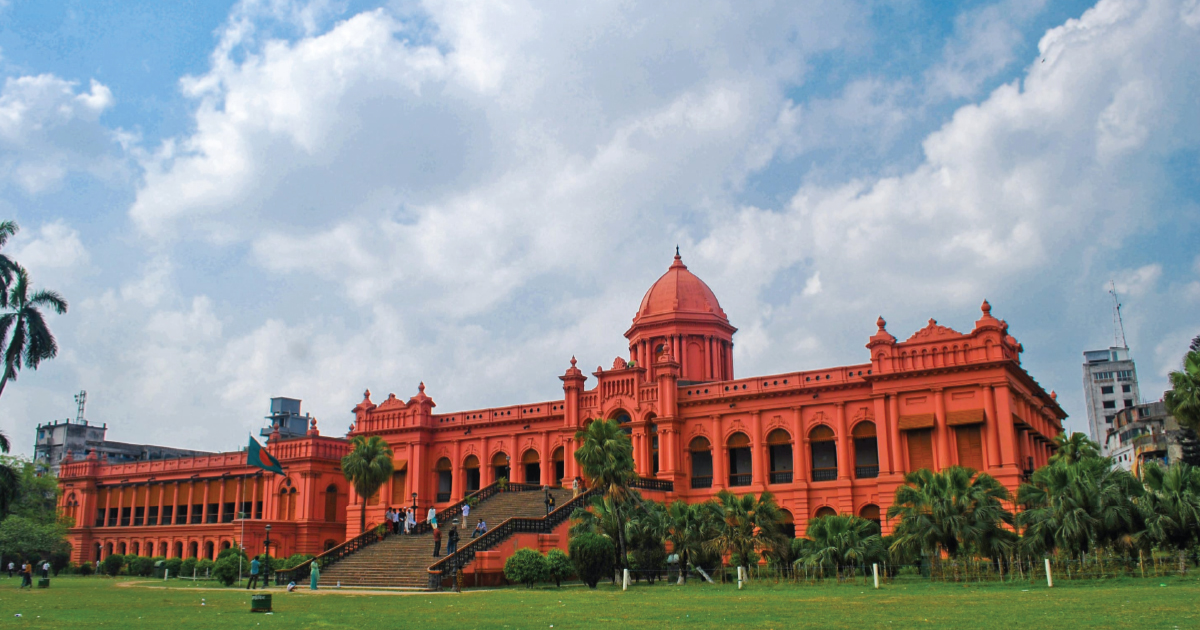With an enriched historic background, Ahsan Manzil is one of the most popular tourist destinations in the city, located in old Dhaka by the side of the Buriganga river

In the age of high-rise buildings, it is difficult to imagine how this majestic palace once dominated the riverfront skyline of Dhaka. Ahsan Manzil is located in the Sadarghat area, a riverfront like no others. The hustle and bustle of Sadarghat can be overwhelming, with boats carrying produce, labourers unloading boxes, and a wild variety of vehicles transporting the goods to their next destination. The streets are packed, the smells pungent, the colours vivid, and the sounds disorienting. In the mayhem that is Sadarghat, the Ahsan Manzil compound is a fenced-off oasis of unexpected peace and quiet.
Once the home of the Nawabs of Dhaka, Ahsan Manzil stands today as a beautiful reminder of Bangladesh’s ugly colonial past. Ahsan Mazil is not just one of Dhaka’s most picturesque sights, but it’s also one of the city’s most historic locations. Its walls were witness to many events from Partition to the ouster of the Nawabs. If you want to get a closer look at the western influenced architecture of the Mughal period and the lavish lifestyle of the Nawabs of Dhaka at that time, you should visit this palace. The luxurious Ahsan Manzil Palace of the then zamindars has now become the Ahsan Manzil museum.
The palace, affectionately referred to as the Pink Palace, was constructed in the late 19th century. It served as a representation of the Bengali aristocracy’s wealth under the British Raj. There is little doubt that this was a distinctive structure in Dhaka at the time, with decorative staircases made of marble, pottery, and wood, and a fake vaulted ceiling. Greco-Roman columns, arches, and the spectacular dome all contribute to the lavish architecture’s largely European influences. The design of the Ahsan Mazil is symmetrical with European architecture and features. The bright pink presents a stark contrast against the banks of the Buringa River and really brings the architectural elements of the Mughal and European empires together, which is a rare sight to see. This was not by accident. The British influenced almost every aspect of life in the subcontinent, including notions of wealth, power and status.
While older architecture from a few centuries before would have reflected more Indian and Mughal influences, the arrival of the British changed much of that. For the Dhaka elite, emulating European dress and manner of speech to separate themselves from the common folk of their country, seemed only natural. It is thus, no surprise that this practice extended to the building of ostentatious homes.
The building is dominated by a large dome that caps an octagonal room, and a wide staircase leading to an arched portal. Along the façade of the building are porticoes that offer expansive views of the Burganga River. Making your way through the gates, one can’t help but be awed by the whimsical atmosphere of the palace as a slight breeze washes over you. The clear blue sky with wispy clouds only adds to the serenity that Dhaka was once adorned with.
In the past, Ahsan Manzil was a place of opulence and frivolity as much as a place of great change. Today, this grand palace of Nawabs serves as a window into a past of bygone times and as a reminder of the fleeting nature of status and wealth. Nowadays, people from all over the world come to visit this popular tourist attraction in the bustling old town of Dhaka.
● Closed on Thursdays
● On Fridays, opens at 3 pm and closes at 8 pm.
● Remains open from 10.30 am to 5.30 pm every other day
● Ticket price
(Bangladeshi) BDT 40
(SAARC tourist) BDT 300
(Other tourists) BDT 500
Visit https://www.ahsanmanzilticket.gov.bd/ to buy a ticket
